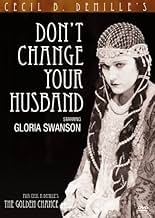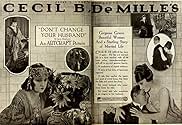अपनी भाषा में प्लॉट जोड़ेंLeila Porter comes to dislike her husband James, a glue king who is always eating onions and looking sloppy. But after she divorces him and marries two-timing playboy Schuyler Van Sutphen th... सभी पढ़ेंLeila Porter comes to dislike her husband James, a glue king who is always eating onions and looking sloppy. But after she divorces him and marries two-timing playboy Schuyler Van Sutphen the now-reformed James looks pretty good.Leila Porter comes to dislike her husband James, a glue king who is always eating onions and looking sloppy. But after she divorces him and marries two-timing playboy Schuyler Van Sutphen the now-reformed James looks pretty good.
- Undetermined Role
- (बिना क्रेडिट के)
- Manager of Gambling Club
- (बिना क्रेडिट के)
- Croupier at Gambling Club
- (बिना क्रेडिट के)
- Member of Gambling Club
- (बिना क्रेडिट के)
- Mr. Frankel - Dressmaker
- (बिना क्रेडिट के)
- Undetrmined Role
- (बिना क्रेडिट के)
फ़ीचर्ड समीक्षाएं
I also thought it was similar to todays life, even though it was produced in 1919, you could relate it to todays time, most women want the good looking man and in the end it doesn't turn out to be what you expected and you want what you did have at one point.
Although the old DeMille formula was beginning to change, and his films were becoming wordier and less purely visual, with such an expressive performer as Swanson we regain much of that silent storytelling style. Her character does very little, but conveys volumes through subtle gesture and facial expression – with a particular talent for looks of disdain. In real life Swanson was herself coming towards the end of her disastrous marriage to Wallace Beery, and it's possible that this fact fuelled her convincing performance.
As if to best complement his leading lady's talents, DeMille's use of framing and close-ups is particularly strong here. He uses cinematic technique to show off the acting – often holding Swanson in lengthy close-ups at key moments – and also to clarify the story visually. For example, when we are introduced to the character of Toodles, she is shown reflected three times in a dressing table mirror. Her character disappears from the story, only to become important towards the end. That attention-grabbing first shot of her helps us remember who she was. Later, at the anniversary dinner, Swanson and future husband number two Lew Cody are framed together in one shot, while Elliot Dexter is isolated in his own frame. Also – and this is a sign of the increasing sophistication of cinema in general – there is much use of reaction shots – for example the disapproving glance of the bishop when Cody acts out his intentions with the wedding figure dolls.
In contrast to DeMille's visual narrative method was the increasingly verbose screen writing of his collaborator Jeanie Macpherson. As I've remarked in several other comments, Macpherson could put together a strong and dramatic story, but like DeMille she tended to state her themes in a somewhat pretentious and flamboyant style. And so we get these very long quasi-philosophical title cards about the pitfalls of married life which, if they improve the story at all, it is only because they are unintentionally funny. For example, only Jeanie Macpherson could come up with a line like "Fate sometimes lurks in Christmas shopping". Fortunately though in this picture these titles mostly introduce scenes rather than break them up.
Although the pictures he made around this time tended to be small scale, it is at this point that DeMille seemed to develop his taste for the spectacular. You can see him start to sneak in excuses for a bit of razzmatazz like the little fantasy scenes of Swanson being showered with "Pleasure, wealth and love". It wouldn't be until the early twenties after the unofficial embargo on historical pictures was lifted that he would get the chance to go all out with the grand spectacle.
All in all, Don't Change Your Husband is a fairly decent DeMille silent picture, although to be honest it is only really the presence Gloria Swanson that lifts it above the average. It's curious though that this is supposedly a comedy, and Swanson was cast at least in part because of her background at Mack Sennett's slapstick factory. She hated comedy acting, and here gives a dramatic rather than a comic performance. It makes sense then that the only straight drama she did with DeMille, Male and Female, was by far the strongest of their collaborations.
For this movie I did not expect how beautiful the setting would be. All the different sculptures, paintings, furniture, rooms and decorations kept your mind thinking and alive as the movie played on. The costumes were beautiful and it was something you don't see often in movies today.
Overall, I would recommend this movie. It was certainly one that kept my interest although it was a bit boring in the beginning. The plot is something that can happen today and it can teach us all a lesson about how to deal with our lives.
Here she plays Leila Porter, the wife of successful but disinterested banker and onion-eater James Denby Porter (Elliott Dexter). Feeling neglected by her husband, Leila leaves him for the charming Schuyler Van Sutphen (Lew Cody), only to discover that her former husband's onion breath is far less of a problem than having an unfaithful and incompetent roustabout for a husband. James undergoes a transformation, including giving up his beloved onions, and is determined to win Leila back. It all makes for a fun and occasionally astute exploration of marital woes. Its strength is that it maintains its light touch rather than endeavoring towards heavy-handedness, and at 80 minutes it breezes by.
Don't Change Your Husband was one of DeMille's silent comedies with a Victorian moral to every one. Here Swanson is a bored wife married to comfortable and stuffy DeMille regular Elliott Dexter. He barely notices the wife any more, keeping his head buried in the newspaper in the morning. He also has a nasty habit of eating raw onions and that will kill romance like nothing else will.
But he's provided for Swanson well including a nice set of jewelry and even though Dorothy Parker hadn't said it yet, diamonds are a girl's best friend.
One day a real Snidely Whiplash type villain Lew Cody starts putting the moves on Swanson. She divorces Dexter and marries Cody. But Cody just wants her jewels for business and to shower on another and badder girl Julia Faye.
DeMille was a child of the Victorian era and this film ends just about as the title suggests. The title itself really gives it all away.
Julia Faye who was one of DeMille's mistresses appeared in most of his feature films right up to the second Ten Commandments. Another was Jeanie MacPherson who was an actress as well as a screenwriter. She did the script for this and many other DeMille films. Lastly there was Gladys Rosson who was his private secretary and on every set right up to The Greatest Show On Earth. He had a regular harem going, but all these women even after the relationship was over were well taken care of work wise.
In fact Faye has one of the more meatier parts in her career as the other woman in Don't Change Your Husband. If this was sound one can only imagine the dialog between Swanson and Faye.
Don't Change Your Husband was the beginning of a fine collaboration between a great director and great star.
क्या आपको पता है
- ट्रिवियाThis is the first collaboration between Gloria Swanson and Cecil B. DeMille.
- भाव
First Title Card: This does not deal with the tread of victorious Armies, nor defeated Huns - but is just a little sidelight on the inner life of Mr. and Mrs. Porter - who found that they should not have looked for their marital troubles with a Telescope - but with a Microscope.
- कनेक्शनFeatured in Boulevard! A Hollywood Story (2021)
टॉप पसंद
विवरण
- चलने की अवधि
- 1 घं 11 मि(71 min)
- रंग
- ध्वनि मिश्रण
- पक्ष अनुपात
- 1.33 : 1

































